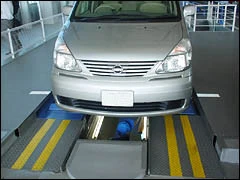Block 4
Items checked at this block
Underbody inspection (Pit type)
・Steering system
・Suspension system
・Brake system
・Engine
・Power train system
・Frame and Body
・Exhaust emission control system
・Fuel system
・Electric system
・Running system
・Underbody inspection (Pit type)
・Underbody inspe

Underbody inspection (Pit type)

An experienced inspector will check the underbody of your vehicle thoroughly by using an inspector hammer and other instruments, and by shaking the tires back and forth, left and right.
Items checked are as follows:
- Whether there is no problem with the steering system
- Whether there is no problem with the suspension system
- Whether there is no false operation or leakage in the brake system
- Whether there is no oil-leakage or other problems in the engine
- Whether there is no problem with the power train system (transmission, differential gear, drive shaft, etc.)
- Whether there is no problem with the body (chassis) and frame of the vehicle
- Whether the muffler is not damaged or installed improperly
- Whether there is no leakage of fuel, etc.
Inspection course operation procedures and precautions
Stop your vehicle at the proper stop line, shift the gear into "neutral" or "P"-range, and stop the engine.
Follow the directions and operate your vehicle as instructed by the display or the inspector.

The hole in the middle is the Pit, where
your inspector will be inspecting.
"Turn the steering wheel": Turn the steering wheel to the left or to the right.
"Step on the brake": Operate the brake.
"Pull on the parking brake": Operate the parking brake.
"Step on the clutch pedal": If your vehicle has a clutch pedal, operate it.

Follow the directions shown by this
displaywhen undergoing
the inspection.
When the result is shown on the display, drive off from the inspection course and stop at the proper spot.
Stop the engine and pull on the parking brake firmly.

Get off from your vehicle with the necessary documents, insert the inspection result slip into the recorder, and record the underbody inspection results.
Do not bend or fold the inspection result slip, and be sure to insert it in the right direction as indicated by the arrow.
